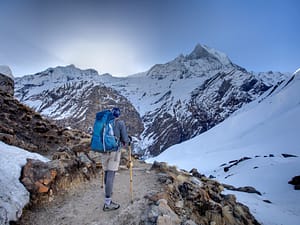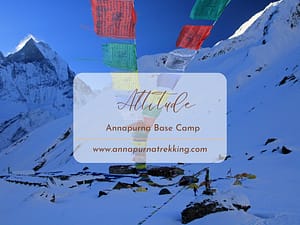Anyone who has seen pictures of the awe-inspiring Annapurna mountain range will understand why a trek through this part of Nepal is top of many bucket lists.
The Annapurna region offers many trekking options, from easy walks to multi-day expeditions. Whether you’re a seasoned hiker or a first-time trekker, the Annapurna region has something to offer everyone. With its stunning landscapes, friendly locals, and rich culture, it’s no wonder this region is one of Nepal’s most popular trekking destinations.
But with so many different routes and options available, planning an Annapurna trek can be daunting. In this ultimate guide, we’ll take you through everything you need to know to make your Annapurna trekking adventure a reality.
From permits and equipment to where to go and when we’ve covered you. So read on for everything you need to know about Annapurna trekking.
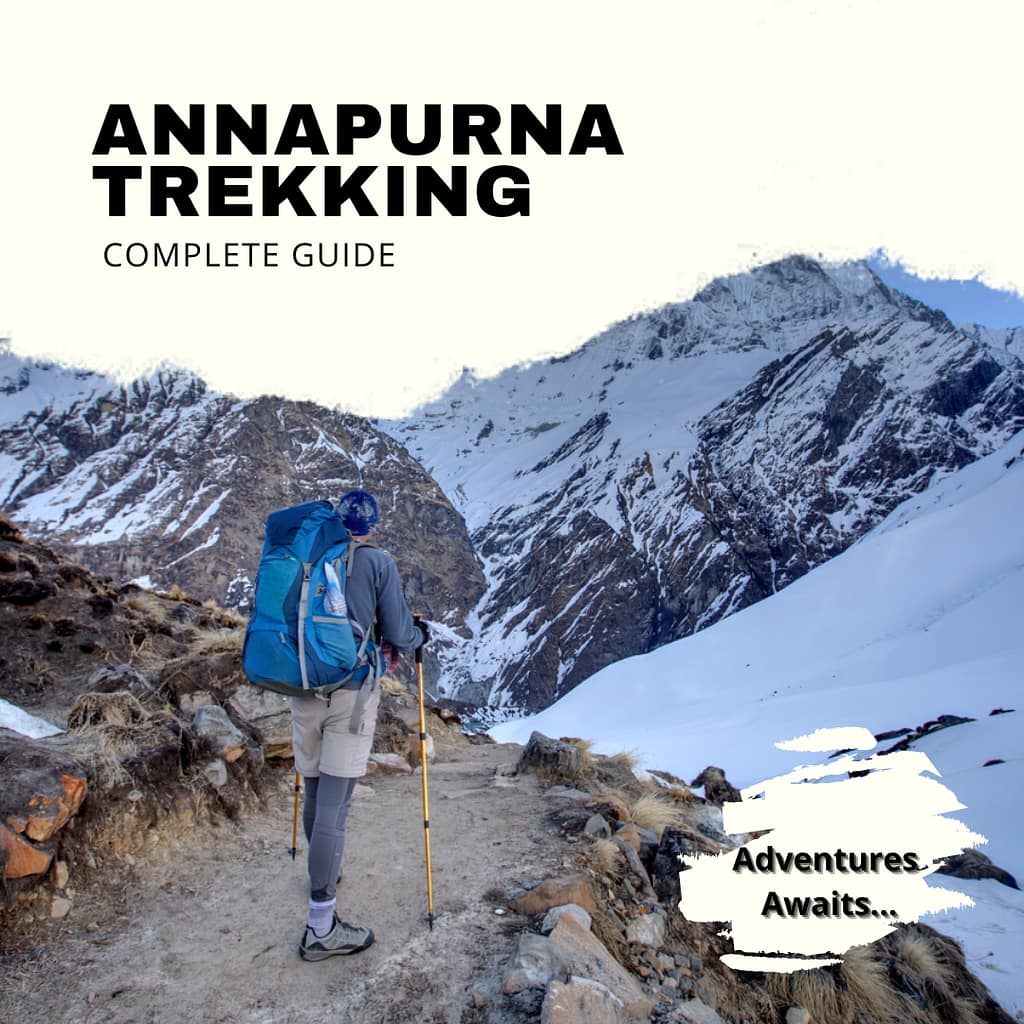
Why should you choose Annapurna?
The answer is straightforward: it’s a spectacular landscape, which is why it’s one of the world’s most popular trekking destinations. Situated in north-central Nepal, the Annapurna region includes several peaks over 7000 meters, including the world’s tenth highest mountain, Annapurna I. With its towering peaks and glacier-fed rivers, it’s no wonder that trekkers come from all over to experience this natural wonder.
The trekking routes through the region are varied and offer something for everyone, from relatively easy treks suitable for beginners to more challenging routes for experienced trekkers. Whichever route you choose, you will be rewarded with stunning views of the Himalayas, including some of the world’s highest mountains.
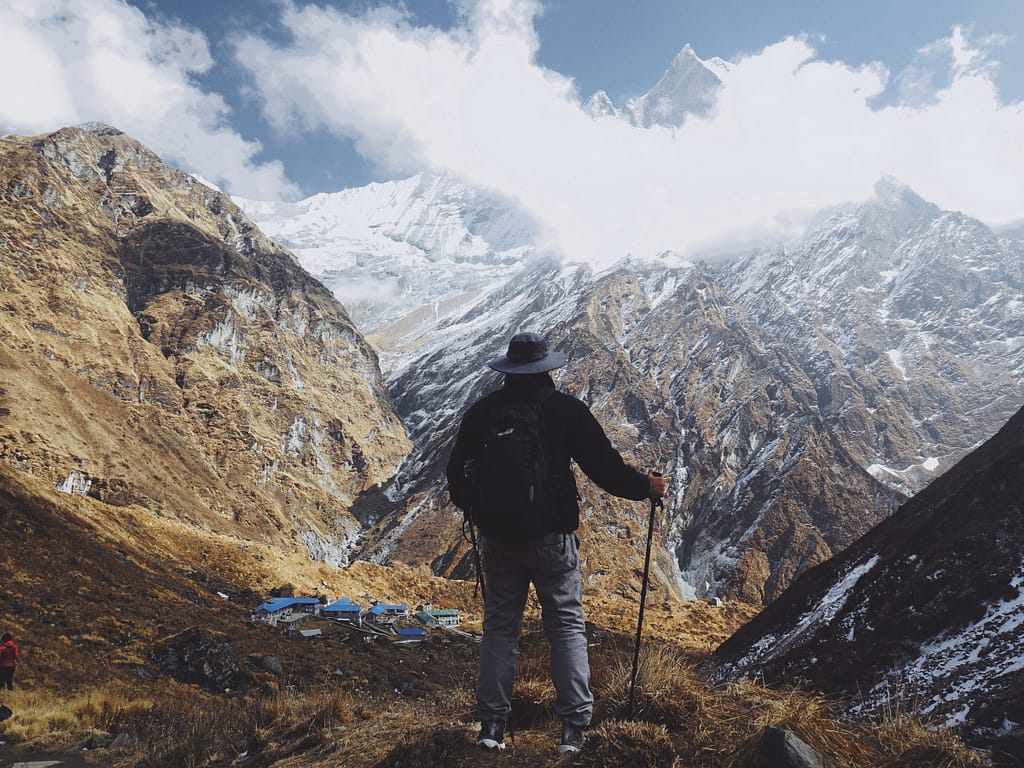
Another reason to choose Annapurna is for its culture. The region is home to diverse ethnic groups with unique cultures and traditions. Trekking through the region is a great way to experience this richness first-hand. You will have the opportunity to meet local people and learn about their way of life.
Finally, Annapurna is an excellent choice for those looking for an adventure. With its challenging terrain and high altitudes, it’s sure to provide any trekker with a test of their mettle. So if you’re looking for an adventure of a lifetime, Annapurna is the place for you.
Where is Annapurna?
The Annapurna region is located in north-central Nepal, about 200 kilometers (120 miles) from the capital Kathmandu. The Kali Gandaki River borders it to the west and the Marsyangdi River to the east.
This region is home to the Annapurna massif, located east of Pokhara. It is part of the Hindu Kush Himalayan range. The massif includes several peaks, including the world’s tenth-highest mountain, Annapurna I Main (the first eight-thousand-meter peak to be climbed ), as well as Annapurna South, Machhapuchhre (also called “Fishtail”), and Hiunchuli. The range is one of the most dangerous to climb: as of 2022, 72 climbers have died on Annapurna I Main alone, and only 365 have successfully submitted it.
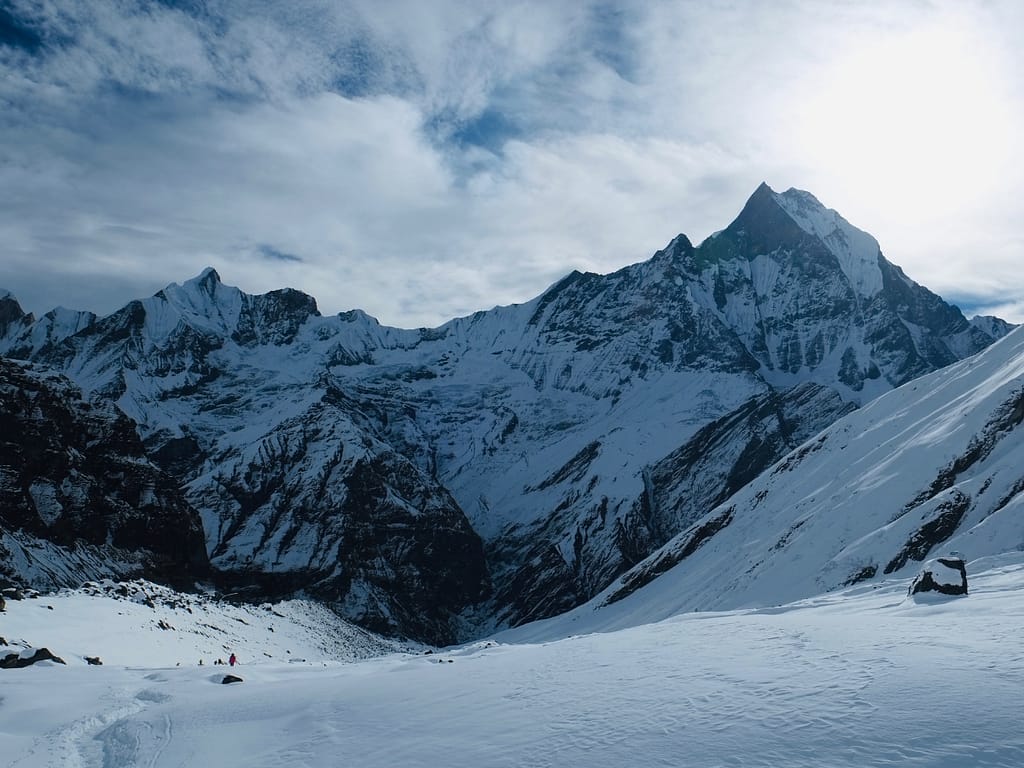
History of the Annapurna Region
Westerners first explored the region in the 1950s when a team of French mountaineers attempted to climb Annapurna I Main. Since then, the region has become increasingly popular with trekkers and mountaineers from all over the world.
The Annapurna Conservation Area encloses the Annapurna Region, Nepal’s first and biggest conservation area, covering 7629 square kilometers. It was established in 1986 by the King Mahendra Trust for Nature Conservation with the primary objective of protecting the unique bio-diversity of the Annapurna region. The conservation area ranges in altitude from just below 1000 meters to the summit of Mt. Annapurna I at 8091 meters and includes the Kali Gandaki Gorge, the world’s deepest gorge.
The area was initially inhabited by the Gurung people,s who still make up the majority of the population in the region. Other ethnic groups include the Magar, Thakali, and Tibetan.
The region has become increasingly popular with trekkers and mountaineers worldwide in recent years. The influx of tourists has brought opportunities and challenges to the locals. On the one hand, tourism has provided a much-needed boost to the local economy. On the other hand, it has also put pressure on the region’s fragile environment.
How hard is the Annapurna region trekking?
The difficulty level of the trekking routes in the Annapurna region varies depending on your chosen route. Easy treks are suitable for beginners and more challenging routes for experienced trekkers.
If you are a beginner, we recommend choosing a shorter and less challenging route, such as the Poon Hill Trek or the Mardi Himal Trek.
If you are looking for a more challenging trek, we recommend the Annapurna Circuit Trek or the Everest Base Camp Trek.
Different trails in Annapurna Region
Annapurna Circuit Trek
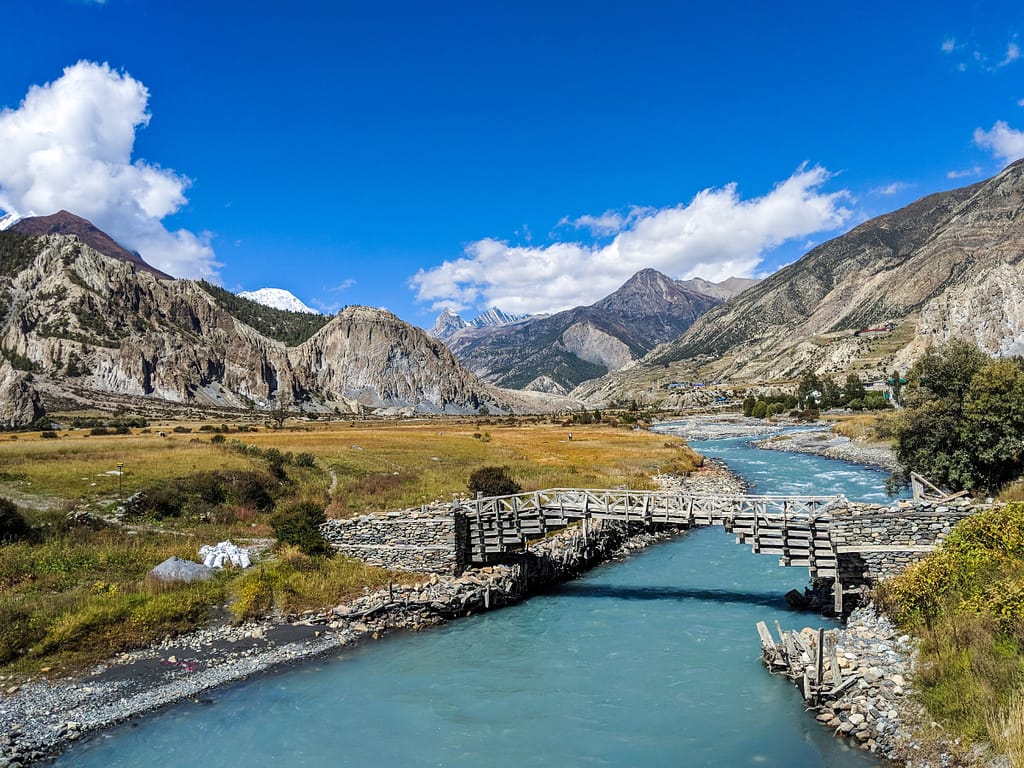
The Annapurna Circuit Trek is a circular route around the Annapurna massif.
The trek takes between 10 and 21 days to complete depending on your fitness level and takes you through various landscapes, from rice paddies and oak forests to snow-capped mountains., The trail reaches a maximum altitude of 5,416m (17,769ft) at Thorung La pass – making it one of the highest treks in the world.
Different route options are available, depending on your fitness level and time constraints.
Annapurna Base Camp Trek
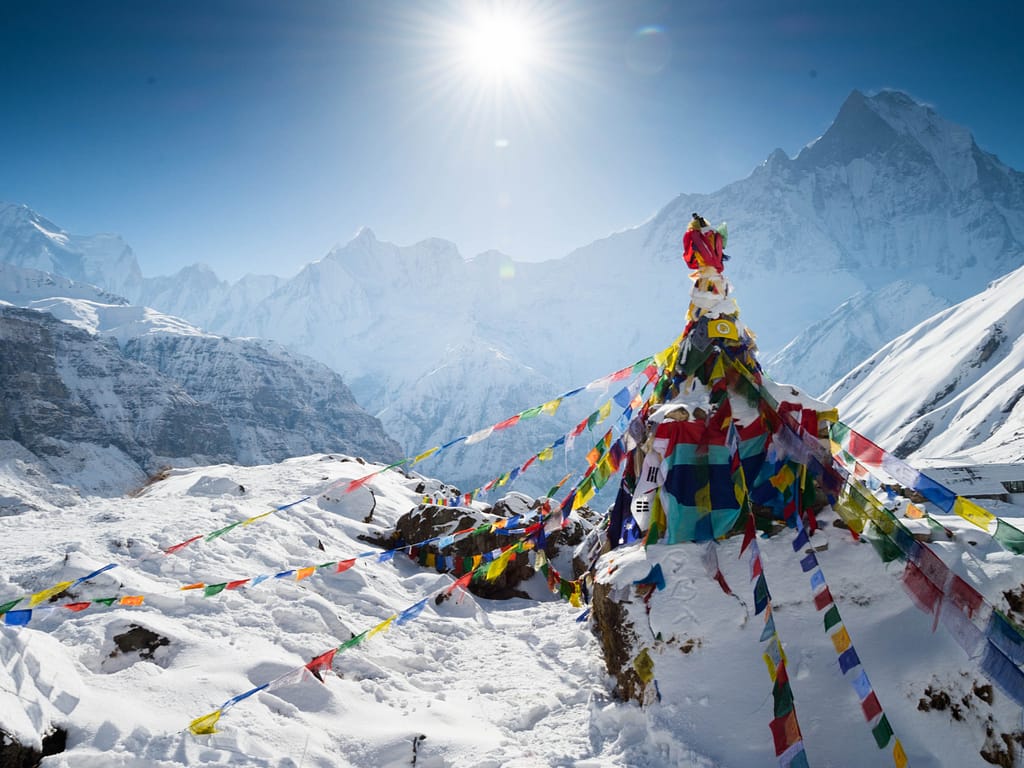
The Annapurna Base Camp Trek is a popular trekking route that takes you to the base camp of Mount Annapurna.
The trail passes through picturesque villages, terraced rice paddies, and rhododendron forests. You will also get views of some of the world’s highest mountains, including Machhapuchhre (Fishtail), Annapurna I Main, and Dhaulagiri.
The trail culminates at the base camp of Mount Annapurna, which sits at an altitude of 4130m (13,546ft).
The trek takes between 12 and 15 days to complete, depending on your fitness level and acclimatization. The first few days of the trek are relatively easy as you make your way through villages and forests. However, as you get closer to the base camp, the terrain becomes more rugged, and the hiking gets more complicated.
Annapurna Circuit trek with tilicho trek
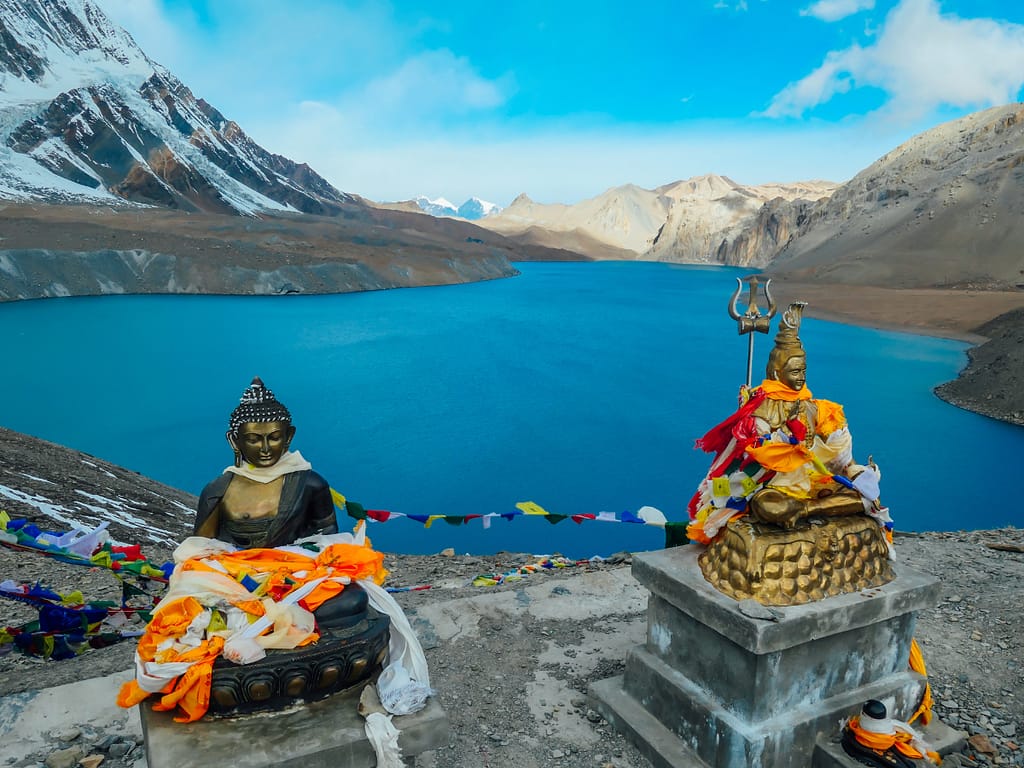
The Annapurna Circuit Trek with Tilicho Trek is a variation of the classic Annapurna Circuit Trek.
The trek takes you through various landscapes, from valleys and forests to glaciers and high-altitude lakes. Tilicho Lake, located at an altitude of 4,919m, is one of the trek’s highlights. The lake is hidden away in a remote corner of the Annapurna region, and reaching it requires an uphill hike of around four hours. However, the effort is well worth it, as Tilicho Lake is one of the most beautiful places in Nepal. The views from the lake are simply stunning, and it’s an unforgettable experience to stand at such a high altitude and look out over the Himalayas.
Poon Hill Trek
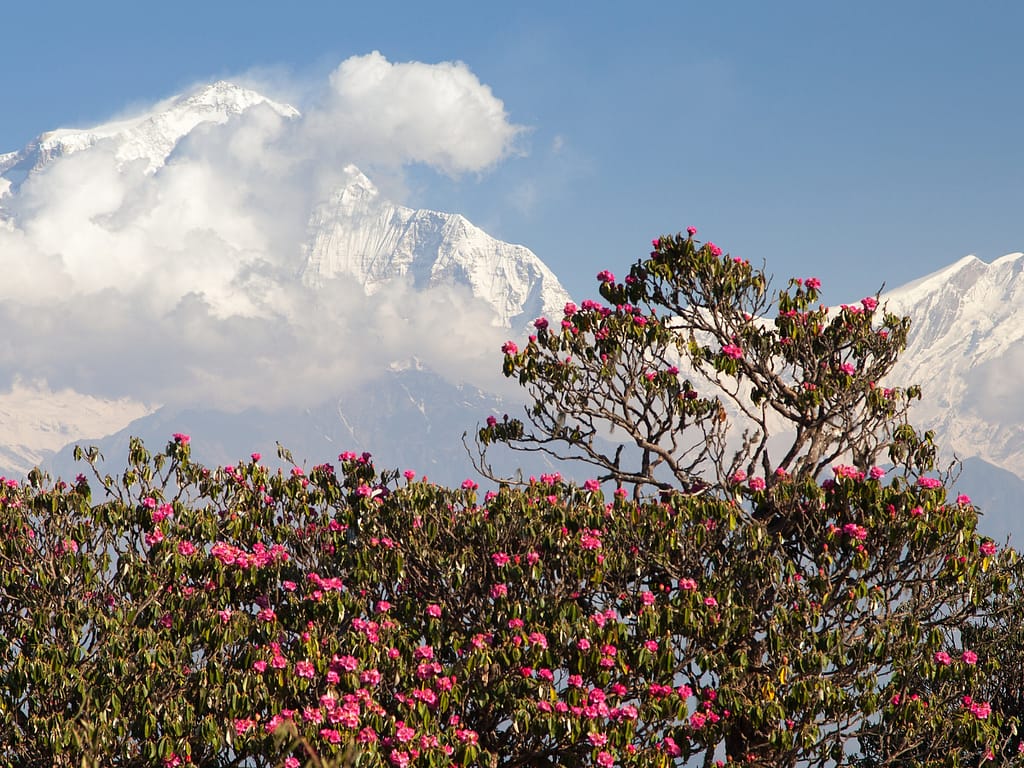
The Poon Hill trek is a shorter and less challenging alternative to the Annapurna Circuit Trek. The Poon Hill trek can be done in 3-5 days, depending on your fitness level and how many stops you want to make along the way. The high point of the trek is Poon Hill (3200m), where hikers can enjoy fantastic views of three of the ten tallest mountains in the world – Dhaulagiri I (8,167m / 7th highest), Annapurna I (8,091m / 10th highest), and Manaslu (8,156 m / 8th highest).
The trail takes you through some of Nepal’s most beautiful scenery, including rhododendron forests, terraced rice fields, and breathtaking Himalayan views. One of the best parts about the Poon Hill trek is that it can be done relatively cheaply and without having to book accommodation in advance – something that can often be challenging (and expensive!) on other more popular treks.
Mardi Himal Trek
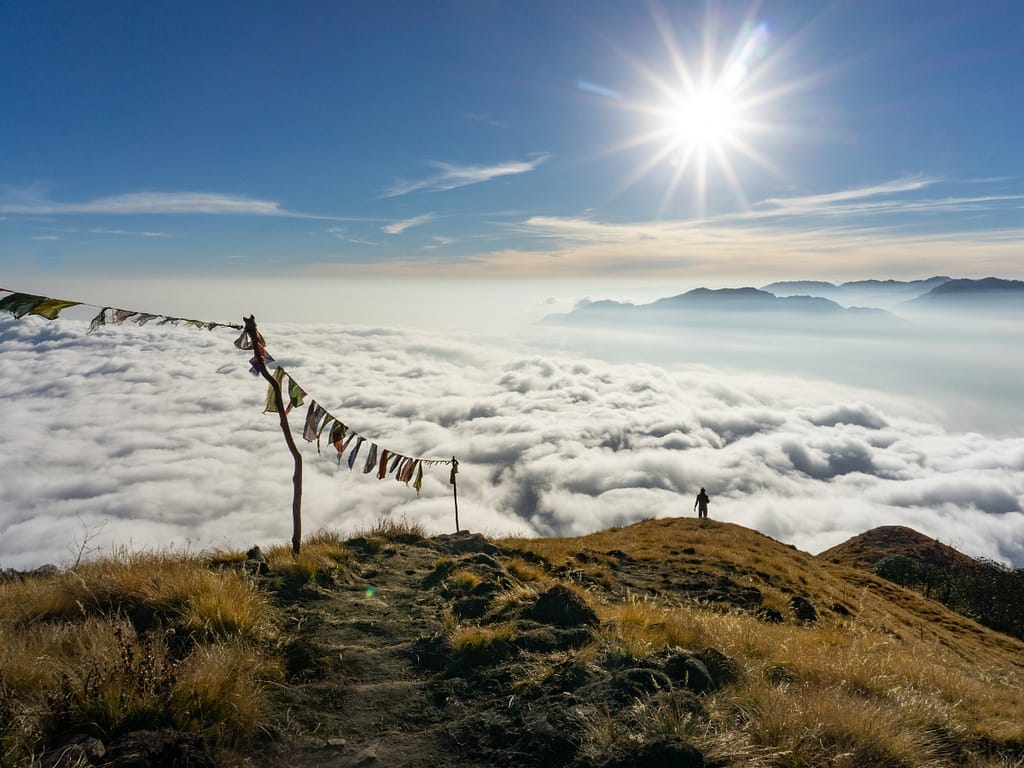
Mardi Himal is located in Nepal, just east of the Annapurna mountain range. The trek is relatively short, at just 5-6 days, and can be completed without hiring a guide or porter.
The Mardi Himal Trek is a moderate difficulty trek that takes you through some of the most beautiful scenery in Nepal. The trek starts at Phedi, a small village about an hour’s drive from Pokhara. From there, it winds its way up through forests and meadows to Base Camp, where you will have stunning views of the Himalayas.
One of the best things about the Mardi Himal Trek is that it is relatively quiet. Because it is not as well-known as some of the other treks in Nepal, you won’t have to contend with large crowds. This also means that you’ll have a more intimate experience with nature.
Kora Ridge Community Trek
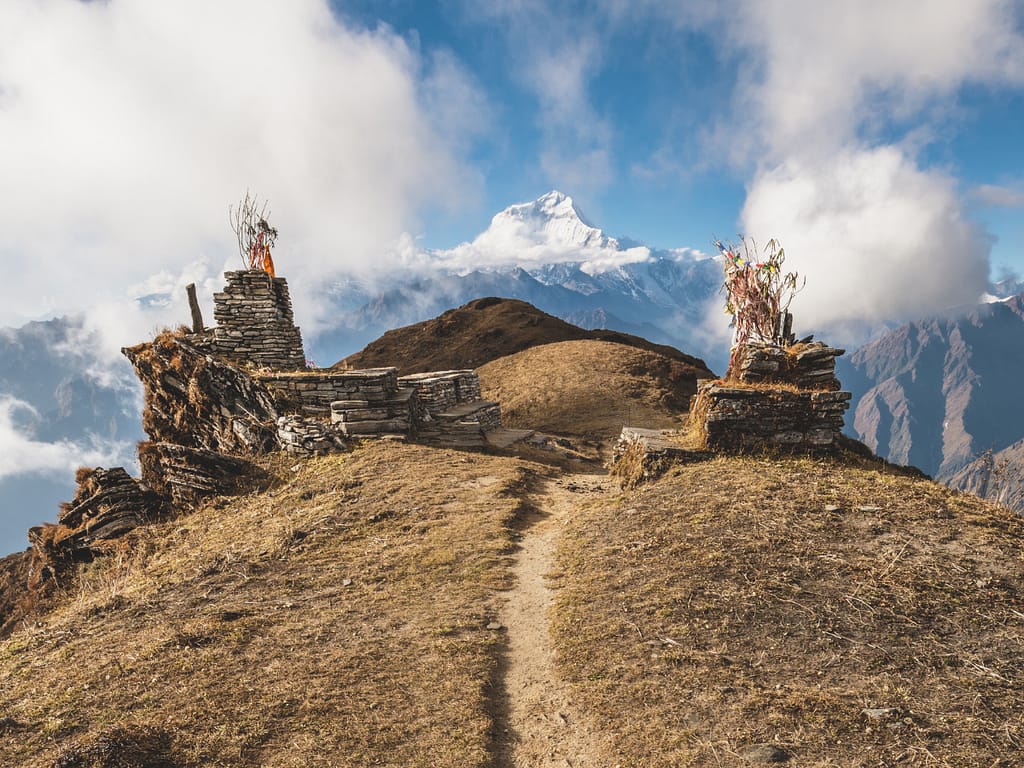
The Khopra Ridge Trek is a relatively new trekking route in Nepal, and one that is quickly gaining in popularity. Despite its recent popularity, the Khopra Ridge Trek is still much quieter than other treks in Nepal, such as Everest Base Camp or Annapurna Circuit.
The Khopra Ridge Trek can be done in 7-10 days, depending on how long you want to acclimate to the altitude. The highest point on the trek is Khayar Lake at 4,665 m, but most trekking is between 3,600 and 4,000 m.
One of the main highlights of the trek is that it offers amazing views of some of Nepal’s most iconic peaks, including Dhaulagiri (8,167 m), Annapurna I (8,091 m), Machhapuchhare (6,993 m), and Nilgiri (7,061 m).
Another highlight is that you will spend a night in a traditional Nepali village homestay. This is a great opportunity to experience true Nepali hospitality and learn about local culture and daily life.
Nar-Phu Valley Trek
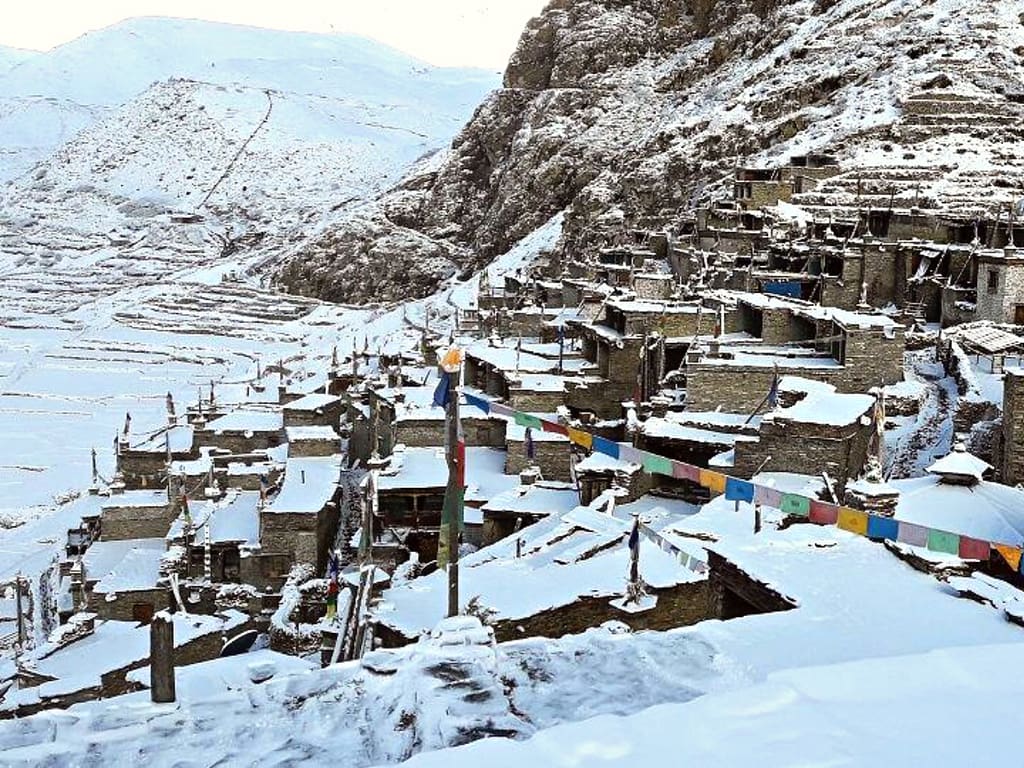
The Nar-Phu Valley Trek is a little-known trekking route in the Mustang region of Nepal. The region is remote and only accessible with a special permit, making it one of Nepal’s most exclusive treks.
The Nar-Phu Valley Trek can be done in 12-14 days, and takes you through some of the most beautiful and unspoiled scenery in Nepal. You will have the chance to see traditional Tibetan villages, ancient monasteries, and stunning views of the Himalayas. The highlight of the trek is Nar Lake, a sacred lake that sits at an altitude of over 4000 m.
Weathers
The Annapurna Area is located in a rain-shadow region, which means it receives far less rainfall than other parts of Nepal. The Himalayas serve as a barrier to the prevailing wind and rain in a rain-shadow region, protecting it from severe weather. Although not completely protected from precipitation, the trek’s northern section may receive less than 10% of monsoon rains.
October to November
The most popular trekking season in the Annapurna region is by far after the Monsoon period. The area comes alive with hikers who are excited to experience hiking in warm weather during the day, with an average temperature of 15 degrees Celsius and crystal clear views. Nighttime temperatures usually remain above freezing (depending on altitude), rainfall is scarce, and there are more sunny days than any other period.
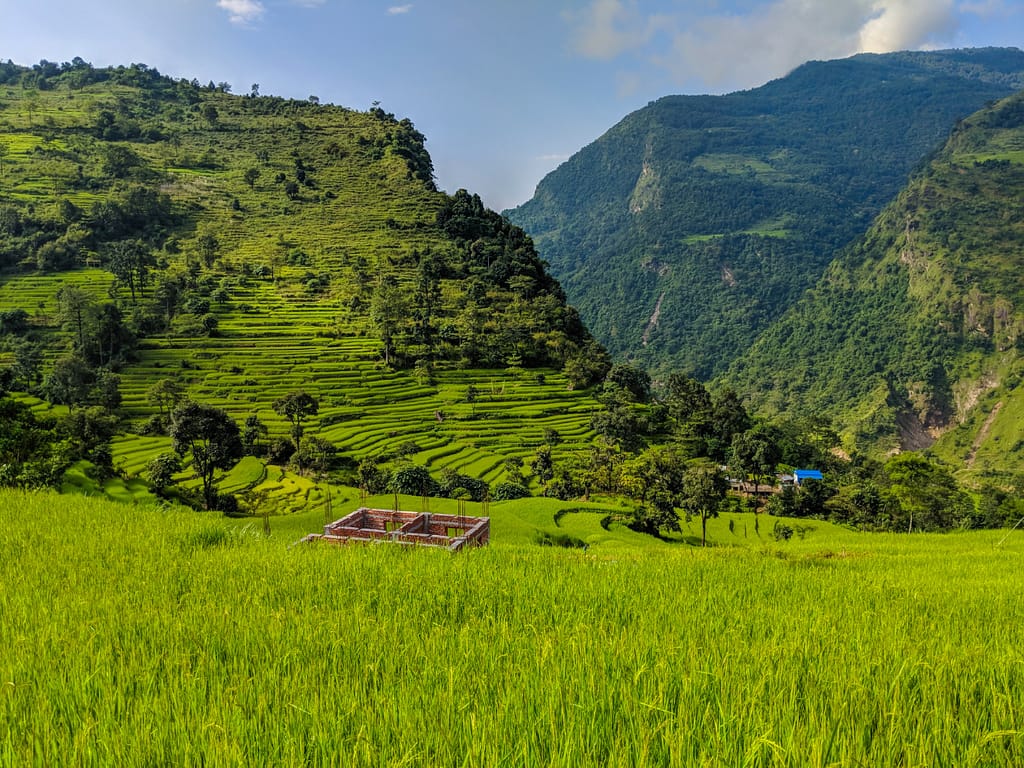
December to March
This is when the Annapurna region’s coldest weather hits. Day temperatures will be quite chilly, and night temperatures will fall well below freezing, depending on your height. Snow is also possible at high altitudes, so be prepared for cold weather if you choose to trek during this time.
Luckly, tea houses are open year-round in the Annapurna region, so you’ll never have to worry about being stranded without shelter. However, some of the lower trails may be inaccessible due to snow.
April to May
This is the start of the pre-monsoon season when the weather starts to warm up again. Although it’s not as hot as October-November, temperatures will be comfortable during the day, with an average of 10 degrees Celsius.
The flowering Rhododendrons are fully bloom during this time, making for a beautiful trekking experience.
The view is vividly clear at high altitudes, with all the peaks being visible. The lower trails may be muddy due to rain, but overall this is a great time to trek in the Annapurna region.
June to September
This is the monsoon season in Nepal, and although it’s technically possible to trek during this time, it’s not recommended. The risk of avalanches and landslides is high, and visibility is often poor due to rain clouds. Not to mention, you’ll be trekking in leech-infested muddy conditions.
That being said, if you don’t mind getting wet, the Monsoon season can actually be a great time to trek. The Annapurna region is less crowded during this time, and you’ll have the trails mostly to yourself.
If you do choose to trek during this time, make sure you have a guide who knows the conditions well and can help you avoid dangerous areas.

Best Season
The best time to trek in the Annapurna region is from October-November after the Monsoon season has ended. The weather is warm and sunny, with excellent visibility. This is also the busiest time of year, so be prepared for crowds on the trails.
If you want to avoid the crowds but still have good weather, April-May is an excellent time to trek. The Rhododendrons are in bloom and the views are stunning. Just be aware that some trails may be muddy due to rain.
How to prepare for the trek?
Now that you know the best time to trek, you need to start preparing for your adventure. Here are a few things you should keep in mind:
Get in shape
Trekking is a physical activity, and you’ll be doing a lot of walking (sometimes up steep hills). Make sure you’re physically prepared for the challenge by doing some cardio and strength training in the months leading up to your trek.
Choose your route
The Annapurna region has many different trails to choose from, ranging in difficulty from easy to challenging. Do some research to find a route that’s right for you and your group.
Pack wisely
You’ll need to pack light, but make sure you have all the essential items for a safe and comfortable trek.
Get travel insurance
This is an important one! Make sure you’re covered in case of injury or illness.
Be aware of the risks
Trekking in Nepal has inherent risks, such as altitude sickness and avalanches. Make sure you are familiar with these risks and know how to avoid them.
Hire a guide
If you are an experienced trekker, hiring a guide is a good idea. They can help you navigate the trails, find accommodation, and deal with any problems.
Hiking with Group vs. Going Solo
One of the most important decisions you’ll make when planning your trek is whether to go with a group or go solo. Both options have pros and cons, so it’s essential to weigh your decision carefully.
Going with a group has many advantages. You’ll have access to experienced guides who can help you navigate the trails and find accommodation. You’ll also be able to take advantage of group discounts on gear and travel insurance.
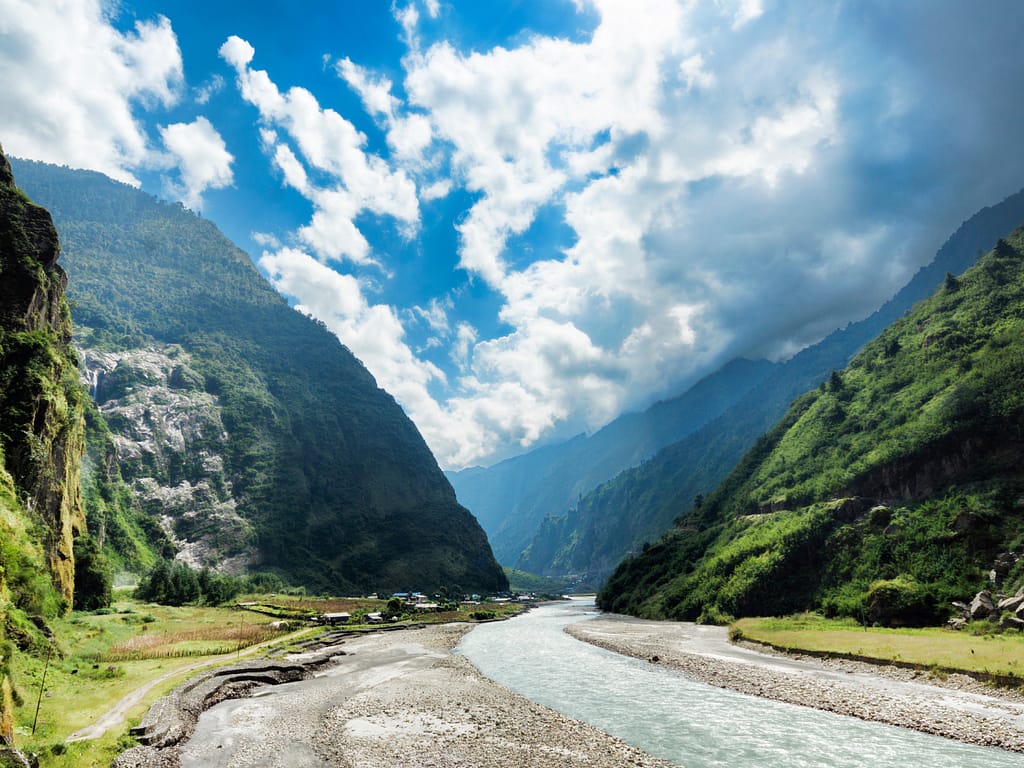
The main downside of going with a group has less flexibility. You’ll need to stick to the group’s schedule and might not be able to explore side trails or linger in villages as long as you’d like.
If you decide to go solo, you’ll have complete freedom to explore at your own pace. You can take side trails, spend extra time in villages, and change your plans on the fly.
The downside of going solo is that you’ll need to be very well prepared. You’ll need to have extensive knowledge of the trails and be comfortable navigating on your own. You’ll also need to carry all your own gear and make all your own arrangements for accommodation and travel insurance.
What will you need for trek for Annapurna trekking?
When planning your trek, it’s important to pack light but ensure you have all the essential items for a safe and comfortable trek. Here are a few things you’ll need:
- Good hiking boots: A good pair of hiking boots is essential for any trek. Make sure they’re broken in before you go so you don’t get blisters.
- Clothing: Pack layers that you can easily take on and off as the temperature changes. Bring a waterproof jacket in case of rain.
- Sleeping bag: If you’re trekking in the off-season, make sure you have a warm sleeping bag.
- First aid kit: A basic first aid kit should include bandages, antiseptic wipes, painkillers, and rehydration powder.
- Trekking poles: These are optional but can be helpful, especially on steep or slippery sections of the trail.
- Headlamp: A headlamp is essential for trekking in the mountains. You’ll need it for early morning starts and late nights when there’s no natural light.
These are just a few of the essential items you’ll need for your trek. For a more complete list, check out here.
How to find the best trekking Company?
When you’re planning your trek, one of the most important decisions you’ll make is choosing a trekking company. There are many factors to consider, such as cost, group size, and itinerary.
One of the best ways to find a reputable trekking company is to ask for recommendations from friends or family who have been on a similar trek. You can also read online reviews, but be sure to take them with a grain of salt.
Once you’ve narrowed down your options, it’s essential to do some research on the company. Make sure they are registered with the Nepal Tourism Board and have all the necessary permits for your trek.
You should also ask about their safety procedures and insurance. Make sure they have a solid plan for dealing with emergencies such as sickness, injury, or bad weather.
Choosing a reputable and experienced trekking company is essential for having a safe and enjoyable trek. Do your research and don’t be afraid to ask lots of questions before making your decision.
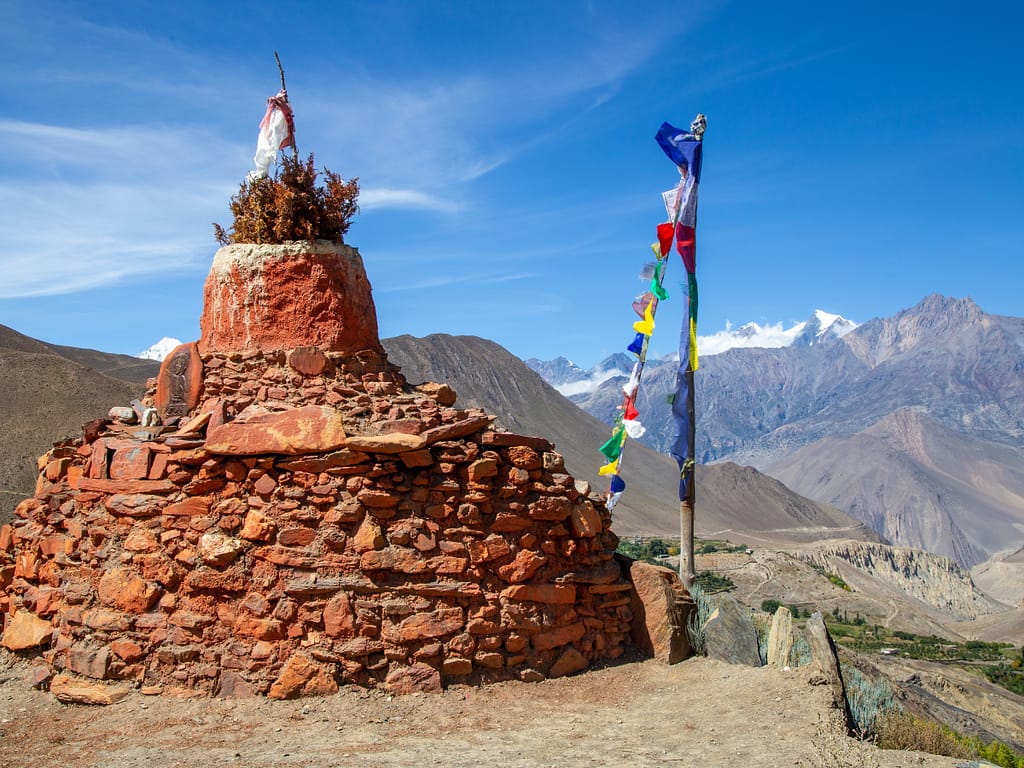
What to expect on the trek?
Trekking in Nepal is an incredible experience that will stay with you forever. The scenery is breathtaking, the people are friendly, and the sense of accomplishment is unbeatable.
However, it’s essential to go into your trek with realistic expectations. Here are a few things you should know:
- You will be tired: Trekking is physically demanding, and even if you’re in good shape, you will be exhausted at the end of each day.
- The weather can be unpredictable: Nepal is a mountainous country, and the weather can change very quickly. Be prepared for all kinds of weather, from blazing sun to snowstorms.
- You must be flexible: Things don’t always go according to plan on a trek. Be prepared to change your plans if the trail is blocked or there’s bad weather.
Conclusion
Trekking in the Annapurna region is a fantastic experience that will stay with you forever. With its dramatic scenery and friendly people, it’s no wonder Annapurna is one of the most popular trekking destinations in Nepal.
Before you go, make sure you are well-prepared by doing your research and packing all the essential items for a safe and comfortable trek. And don’t forget to choose a reputable trekking company that will take care of you on your journey.
With a little preparation and some flexibility, you will indeed have an amazing time trekking in Nepal. So what are you waiting for? Start planning your trek today!


